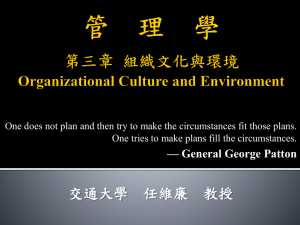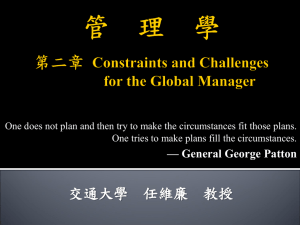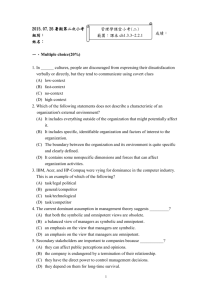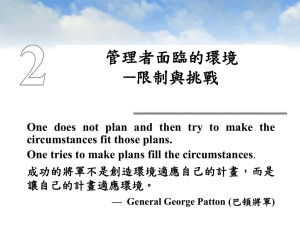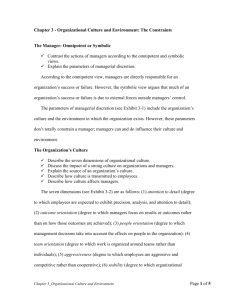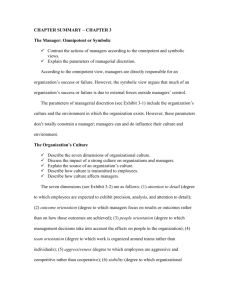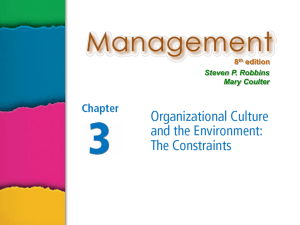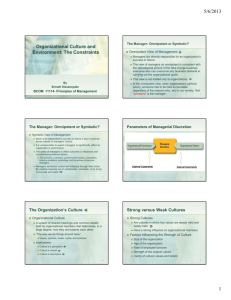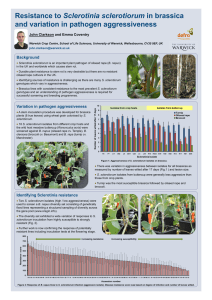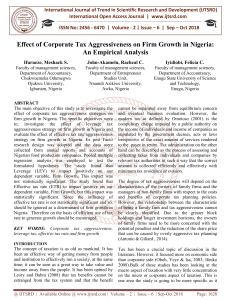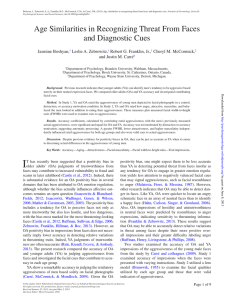Ch3 - 任維廉
advertisement
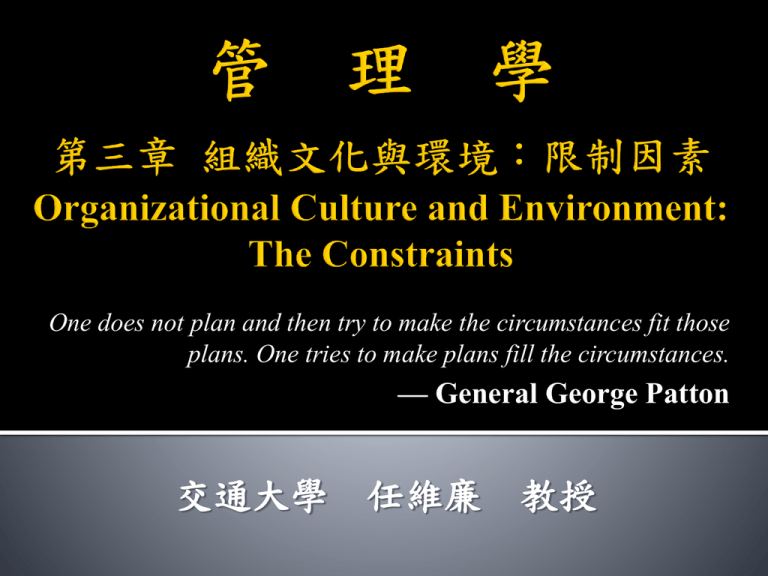
One does not plan and then try to make the circumstances fit those plans. One tries to make plans fill the circumstances. — General George Patton 交通大學 任維廉 教授 1. The Manager: Omnipotent or Symbolic? 2. How Culture Affects Managers? How Employees Learn Culture? 3. How the Environment Affects Managers? 2 1. 管理者:全能 (omnipotent) 或象徵 (symbolic) 2. 組織文化 (culture) 3. 組織環境 (environment) 3 1. 全能觀點 2. 象徵觀點 3. 綜合觀點 4 Managers are directly responsible for an organization’s success or failure. The quality of the organization is determined by the quality of its managers. 討論:切腹下台,提頭來見! 5 Much of an organization’s success or failure is due to external forces outside of managers’ control. The economy, customers, governmental policies, competitors, industry conditions, technology, and the actions of previous managers 討論:成功模式? 6 例:面對交警 Organizational Culture Managerial Discretion Organization’s Environment 7 1. 定義 (definition), 向度 (dimensions), 衡量 (measurement) 2. 起源,學習,影響 討論: 1. 人格特質 (personality) 之構面:big 5 (p.428) 2. OCA: organizational culture assessment, (Reigle, 2003) 8 A system of shared meanings and common beliefs held by organizational members that determines, in a large degree, how they act towards each other. “The way we do things around here.” Values, symbols, rituals, myths, and practices Implications: Culture is a perception, shared, descriptive. 討論:人人都是無價之寶! 9 10 Dimension Attention to Detail Outcome Orientation People Orientation Team Orientation Aggressiveness Stability Innovation and Risk Taking Organization A Organization B High Low Low Low Low High Low Low High High High High Low High 11 Are cultures in which key values are deeply held and widely held. Have a strong influence on organizational members. Factors Influencing the Strength of Culture Size, Age, Strength Rate of employee turnover, Clarity of cultural values and beliefs 12 13 Sources The organization’s founder: Vision and mission Past practices of the organization The behavior of top management Continuation Recruitment of like-minded employees who “fit” Socialization of new employees to help them adapt to the culture 14 Stories Narratives of significant events or actions of people Rituals Repetitive sequences of activities that express Material Symbols Physical assets distinguishing the organization Language Acronyms and jargon of terms, phrases, and word 15 飲水思源 Stay hungry, stay foolish. Be nice. Do your best, Keep it in perspectives. 16 皮質萬用盒 紅鉛筆(榮譽榜,講座) 紀念金幣 受邀參觀創辦人城堡 Bonus: 上網找經理人月刊, 2007.7, p.104 17 18 Be a visible role model. Communicate ethical expectations. Provide ethics training. Visibly reward ethical acts and punish unethical ones. Provide protective mechanisms so employees can discuss ethical dilemmas and report unethical behavior without fear. 19 Hire service-contact people with friendliness, enthusiasm, attentiveness, patience, concern about others, and listening skills. Train them continuously by focusing on improving product knowledge, active listening, showing patience. Socialize new service-contact people to the organization’s goals and values. Design customer-service jobs so that employees have as much control as necessary to satisfy customers. Empower service-contact employees. Convey a customer-focused vision and demonstrate. 20 Workplace Spirituality The recognition that people have an inner life that nourishes and is nourished by meaningful work that takes place in the context of community. Characteristics of a Spiritual Organization Strong sense of purpose Trust and openness 討論:威盛,長榮,杜俊元,游芳來。 21 1. 堅持高度職業道德 2. 專注於專業積體電路製造服務本業 3. 放眼世界市場,國際化經營 4. 注意長期策略,追求永續經營 5. 客戶是我們的夥伴 6. 品質,7.創新,8.工作環境,9.管理模式 10. 兼顧員工股東,回饋社會 22 Integrity(誠信正值) Customers are partners(客戶是夥伴) Innovation(製程創新) Commitment(對客戶承諾) 23 1. 2. 3. 4. 5. 6. 7. Discipline Transparence Independence Accountability Responsibility Fairness Social awareness RD IS FAT 24 A公司 Innovation 4 3 Stability Attention to detail 2 1 0 Aggressiveness Outcome Team People 25 補習班 Innovation and risk taking 4 Stability B 補習班 C 補習班 3 Attention to detail 2 1 0 Aggressiveness Team orientation Outcome orientation People orientation 26 貿易公司 Innovation and risk taking 4 3 Stability Attention to detail 2 1 0 Aggressiveness Team orientation Outcome orientation People orientation 27 D 公司 Innovation and risk taking 4 Stability 3 Attention to detail 2 1 0 Aggressiveness Team Orientation Outcome Orientation People Orientation 28 E公司 Innovation and risk taking Stability Aggressiveness Team Orientation Attention to detail Outcome Orientation People Orientation 29 F公司 vs. G公司 Innovation F 公司 G 公司 4 Stability 3 Attention to detail 2 1 0 Aggressiveness Team orientation Outcome orientation People orientation 30 1. 定義 2. 特定 (specific) 環境: SCCP 供應商,顧客,競爭者,壓力團體 3. 一般 (general) 環境: STEPGD 社會文化,科技 ,經濟,政治法律, 全球,人口統計。 討論:HMO, PEST, 寵物商機,老婆, 一把槍一個子彈。 31 Those factors and forces outside the organization that affect the organization’s performance. Components Specific: external forces that have a direct and immediate impact on the organization. General: broad economic, socio-cultural, political/legal, demographic, technological, and global conditions that may affect the org. 32 General Environment Suppliers Customers The Organization Public Pressure Groups Competitors Specific Environment 33 34 Any constituencies in the organization’s environment that are affected by the organization’s decisions and actions Why Manage Stakeholder Relationships? It can lead to improved organizational performance. It’s the “right” thing to do given the interdependence of the organization and its external stakeholders. 35 1. Identify the organization’s external stakeholders. 2. Determine the particular interests and concerns of the external stakeholders. 3. Decide how critical each external stakeholder is to the organization. 4. Determine how to manage each individual external stakeholder relationship. 36 1. 利潤最大化 2. 股東財富最大化 3. 市場佔有率 4. 顧客忠誠度 5. 員工滿意度 6. 其他 Stakeholders 37 38 1. Case study: a manager’s dilemma (p.87) 2. Thinking critically about ethics (p.100) 3. Internet-based exercise (p.112) 4. Team-based exercise (P.115) 39 比較:1. 管理者之全能,象徵,綜合觀點 2. 個人人格 VS. 組織文化 3. 一般環境 VS. 特定環境 40 1.全球經濟持續成長 2. 藝術取代運動 3. 走向資本主義 4. 流行文化 5. 解除管制 6. 太平洋經濟重心 7. 女性出頭 8. 生物科技及爭議 9. 宗教復甦 10. 重視個人貢獻 常用詞: change, greenwashing, Chinglish… 新創詞: leisure sickness, cyberchondriac, youthanasia… 41 1. 繪製貴公司組織文化雷達圖。 實例:新竹縣文化中心 比較:政大,交大。華航,長榮。IBM, Apple. 討論:裕隆汽車。 2. 分析貴公司之組織環境, 討論:走向有利或不利之方向? 42 omnipotent view symbolic view organizational culture strong cultures socialization workplace spirituality external environment specific environment general environment environmental uncertainty environmental complexity stakeholders 43
